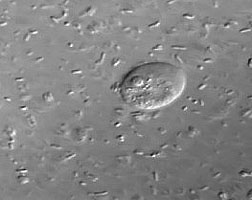This page has been archived and is being provided for reference purposes only. The page is no longer being updated, and therefore, links on the page may be invalid.
Catch the Subterranean Slug-Fest—Now, Live on Video
By Jan SuszkiwDecember 1, 2009
To learn of Mark Mazzola's research, you'd think the amoebas he studies—and the bacteria they "stalk" in the soil—were lion and wildebeest battling it out on the plains of the Serengeti in East Africa.
The Agricultural Research Service (ARS) plant pathologist is studying such microbial strife as part of a broader effort to devise new, integrated approaches to managing "apple replant" disease. In western states including Washington, this growth-sapping disease of young trees can cause diminished gross returns of up to $40,000 over 10 years, an orchard's average productive life.
A complex of pathogens causes the disease, notably Rhizoctonia fungi, Pythium oomcetes and the parasitic nematode Pratylenchus penetrans. Chemically fumigating the soil helps suppress them, but the practice is costly and environmentally worrisome.
As an alternative, Mazzola is examining ways to bolster resident populations of Pseudomonas bacteria, whose habitation of soils around tree roots helps keep the pathogens at bay. While conducting research at the ARS Tree Fruit Research Laboratory in Wenatchee, Wash., Mazzola observed something interesting. When pursued in soils by single-celled predatory amoebas, the rod-shaped Pseudomonads "band together" and secrete a biochemical defense of surfactant-like proteins, called cyclic lipopeptides (CLPs).
Normally, the amoebas hunt down and engulf their prey with the help of "false feet." But the Pseudomonads' CLPs stop them cold—or, more precisely, blow them apart, reports Mazzola, who's videotaped the action.
His observations are based on petri dish, soil-tube and plant-root experiments pitting two CLP-producing strains (P. fluorescens SBW25 and SS101) and two nonproducing mutant strains (17A8 and 10.24) against the amoeba Naegleria americana. In the experiments, the amoeba avoided areas inhabited by SBW25 and SS101, but "overran" and feasted upon the CLP-free mutant strains.
Besides survival, the CLPs also enable the Pseudomonads to form biofilms, further contributing to their usefulness as apple replant controls, according to Mazzola.
He and Wageningen University co-investigator Jos Raaijmakers report their findings, including the identification of two CLPs—viscosin and massetolide A—in the November issue of Applied and Environmental Microbiology online.
ARS is the principal intramural scientific research agency of the U.S. Department of Agriculture.

